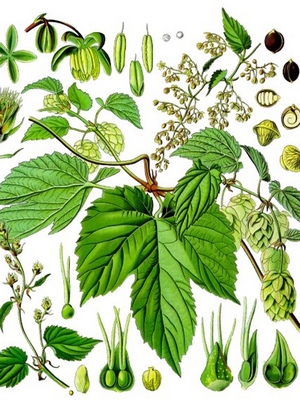Hops ordinary – Humulus lupulus L
Climbing herbaceous perennial plant, growing to 4-5 m length of the mulberry family (Cannabaceae). It grows almost all over Europe widely cultivated for food industry. With the purpose of treatment use inflorescences (bumps) plants.

Hop chemical composition
Ripe hop cones contain the bitter substance lupulin, essential oil, which includes myrcene, rubbery, farnese. Besides, the alkaloid humulin was found in the buds of the plant, hormones, chlorogenic, valeric and hop killing acids, flavonoid glycosides, kumarinы, coloring and resinous compounds, vitamins (rutin, IN1, IN3, IN6, PP) and other compounds.
Pharmacological properties of hops
The neurotropic effect of herbal preparations from hop cones is associated with the presence of lupulin in them, has a calming effect on the central nervous system. Flavonoids in the plant, hormones and vitamins cause anti-inflammatory, antiulcer, capillary strengthening, hyposensitizing and analgesic properties of hop cone extract. The positive effect of herbal hop preparations on metabolic processes and especially on the regulation of fat, mineral and water exchange. In an experiment on animals, Besides, the active effect of hops on the regeneration processes in the epidermis of the skin has been established, in the mucous membranes and improving the vital functions of the hair follicles, and also revealed the bactericidal and fungicidal properties of the plant. There is evidence, that hop cones are estrogenic.
The use of hops in medicine
Hop cone extracts are widely used in cosmetics and dermatological practice.. On the basis of hops, the industry produces a number of medicinal creams and solutions, designed to eliminate dandruff, strengthening hair, dermatitis treatment, blackheads, cheilites. For this purpose, an infusion of hop cones is also used.. Besides, described a positive experience of using infusion of hop cones for skin inflammatory diseases, in particular for chronic leg ulcers.
Anti-inflammatory, painkillers, bactericidal and antiallergic properties of galenic hop preparations determine their therapeutic effectiveness in diseases of the skin and mucous membranes, accompanied by inflammatory lesions, allergic manifestations, itching and other symptoms. Especially good results were noted for allergic and occupational dermatitis, dystrophic processes in mucous membranes and skin.
Water infusions from ripe hop inflorescences are prescribed to stimulate appetite, improving digestion with gastritis, gastroenteritis, for diseases of the gallbladder and liver. Quite often, hop cones are used together with other medicinal plants for diseases of the urinary tract and kidneys as an anti-inflammatory, hyposensitizing, diuretic and mineral metabolism regulating agent.
The sedative properties of the plant are used for increased nervous excitability., sleep disorders, vegetative-vascular dystonia and climacteric disorders. For this purpose, an infusion of hop cones is used or the plant is used as a collection in combination with other plants of a calming effect., for example in sedative formulations.
Hop oil is a part of the drug "Valocordin". It is prescribed for neuroses with increased irritability., mild spasms of the coronary vessels, tachycardia, insomnia, intestinal spasms, as well as in the early stages of hypertension. The drug was well tolerated. In some cases, during the daytime, drowsiness and light dizziness may occur., which pass when the dose of valocordin is reduced.
In case of an overdose of herbal preparations of hop cones, side effects are possible: nausea, vomiting, abdominal pains, headache, feeling of general tiredness and weakness.
Hop dosage forms, Dosing and Administration
Hop cone infusion. Cooking method: 1 pour a tablespoon of chopped hop inflorescences 200 ml boiling water and heat in a water bath for 15 m, cool, filter. Take 1/4 cup 3 times a day before meals; for external use, moisten a gauze bandage with infusion.
Collection sedative cm. Valerian lekarstvennaya
Valocordin. Drops composition: ethyl ester of α-bromoisovaleric acid - 2 g, sodium salt of phenylethylbarbituric acid - 2 g, hop oil - 0,02 g, peppermint oil - 0,14 g, ethanol - 48 g, distilled water to 100 g. The drug is administered orally with a small amount of water or on a lump of sugar, starting from 5-10 drops with a gradual increase to 15-20 drops 2-3 times a day; with tachycardia, take on 30-50 drops to the reception.
Available in dropper bottles. Store in a cool,, protected from light.
